Accidental ingestion of fidget spinner parts by infants
Recently, fidget spinners have become popular as hand playing toys for a wide age range. In general, a fidget spinner consists of a bearing in the center of a multi-lobed flat structure with weights. A person holds the center pad with two fingers while the toy spins. (See Photo 1)
Photo 1. Fidget spinner being spun
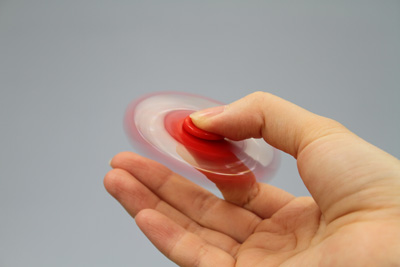
It was reported in the US that a 10-year-old girl swallowed a fidget spinner part, which was removed by surgery. CPSC (United States Consumer Product Safety Commission) alerted that children might accidentally ingest or choke on small parts of fidget spinners and that their digestive tracts might be burned due to accidental ingestion of button batteries1. In Japan, the Japan Toy Association has revised the safety toy standard2 to add some requirements (e.g. Not to use any ancillary part that might come off while spinning; to show a caution message "Do not throw it at persons, animals or objects")3.
The Medical Facilities Network4 has received two reports of accidental ingestion of fidget spinner parts in August 2017. Incidents of accidental ingestion of or choking on fidget spinner parts by children may increase. Therefore, NCAC checked caution labels on the products and examined whether or not small parts may come off to share relevant information and issue an alert.
- 1 On August 10, CPSC opened the Fidget Spinners Safety Information Center to the public on the web to issue an alert on choking on and accidental ingestion of fidget spinner parts by children and ignition of rechargeable products.
https://www.cpsc.gov/Safety-Education/Safety-Education-Centers/Fidget-Spinners-Safety-Information-Center - 2 The Safety Toy Standard, developed by the Japan Toy Association, consists of three parts: mechanical and physical characteristics; flammability; and chemical characteristics.
- 3 The Japan Toy Association released "How to handle fidget spinners under the safety toy system" and added some requirements to the Safety Toy Standard (requirements on ancillary parts, requirements on caution labels related to small parts and risky ways of playing with it).
http://www.toys.or.jp/st/pdf/2017/jta_handspinner_20170726.pdf - 4 The Medical Facilities Network is a joint project by the Consumer Affairs Agency and NCAC which started operating from Dec. 2010. The network collects accident reports on people receiving treatment at medical facilities after suffering life-threatening or bodily injuries in their daily lives. The above data includes reports registered from December 2010 through the end of February 2018.
Accident reports received by NCAC
Regarding one out of the two accident reports received by the Medical Facilities Network, NCAC gained cooperation from the victim's parent, with whom NCAC interviewed to hear details of the accident. Then, NCAC examined the product.
- [Case1]
- A boy accidentally ingested three metal parts of a fidget spinner. His parent saw that the boy swallowed one part. Two days later, the boy saw a doctor. X-ray photography showed one object in his large bowel and two objects in his small bowel. On the next day, the three parts were excreted with the stool by two bowel movements.
- (boy aged one year and three months)
(1) The actual product and the same type product
The actual product used by the boy had been already disposed of. Instead, the boy's parent provided the same type product which had been bought at the same time (See Photo 2). NCAC checked the same type product and found that the ingested metal part was 14.0 mm in diameter, 6.0 mm in thickness, and 7.1 g in weight.
Photo 2. Appearance of the same type product
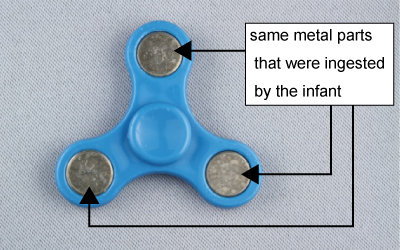
(2) Background of the accident
Two out of three brothers were given capsule toys containing fidget spinners one by one. The elder brother told that small parts had come off after dropping the fidget spinner and he began to use fidget spinners without the parts. The three parts were left on the floor. Their parent saw that the youngest brother aged 15 months put one of the parts in his mouth. The parent looked for other two parts, but did not find them. At that night, the boy cried intensely. His parent touched the boy's belly and felt something small and hard inside. Two days after the accidental ingestion, the boy saw a doctor in the evening. X-ray photography showed some foreign objects in his belly (See Photo 3). The doctor advised to wait for his bowel movements. Three days after the accidental ingestion, the boy had two bowel movements and excreted three metal parts (See Photo 4).
Photo 3. Abdominal X-ray 5
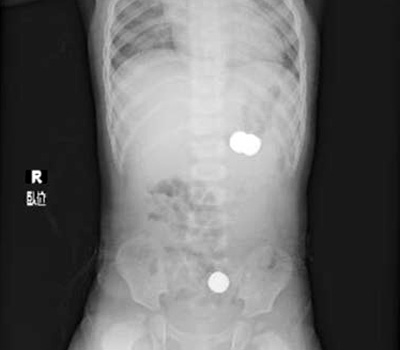
Photo 4. Three parts accidentally ingested 5
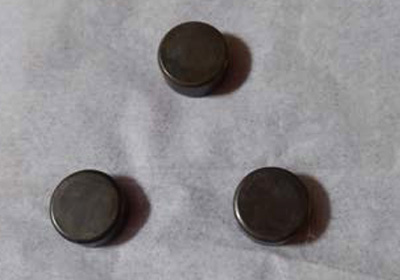
- 5 The abdominal X-ray was provided by the medical facility concerned and the photo of the three parts was provided by the infant's parent.
Fidget spinner
A fidget spinner has a bearing in its center, which is vertically held between two caps (herein after called "bearing caps"), and several wings radiated from the center. Usually, a person holds the two bearing caps with two fingers while the toy spins (See Diagram 1).
Diagram 1: Common structures of fidget spinners and their part names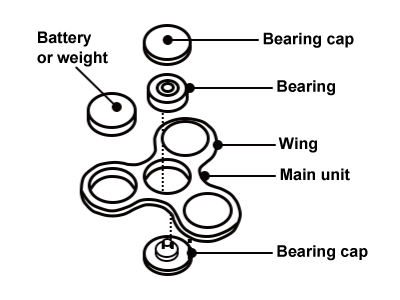
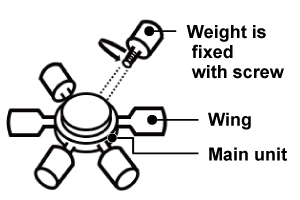
Investigation of marketed products
(1) Investigation period
- Purchase of specimens
- December 2017 - January 2018
- Investigation period
- December 2017 - February 2018
(2) Brands investigated
Fidget spinners in the market are varied in shape and structure. The number and shape of removable parts thereof differ depending on models. In order to investigate products which are highly likely to be purchased by consumers, NCAC chose 90 brands (price: from 108 yen to 5,940 yen) from those ranked high in the search results on major online shopping malls6. The 90 brands are roughly divided into three types of structure: 1) wings are embedded with parts (embedded-type); 2) wings are screwed into the center pad (screw-in type); 3) the center pad and wings are all in one piece (all-in-one type). (See Diagram 2) Incidentally, all the investigated brands did not have the safety toy mark of the Japan Toy Association.
- 6 Internet search as of December 4, 2017
Three types of structure of the 90 investigated brands
Embedded type
Wings are embedded with parts
18 brands(6 brands are with button batteries)
typical embedded types
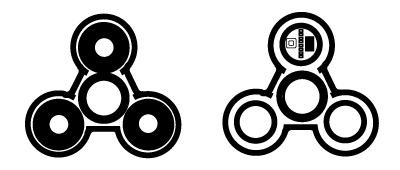
Screw-in type
Wings are screwed into the center pad
28 brands
typical screw-in types
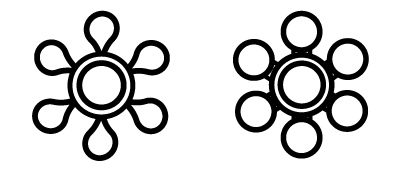
All-in-one type
The center pad and wings are all in one piece
44 brands(5 brands are with button batteries)
typical all-in-one types
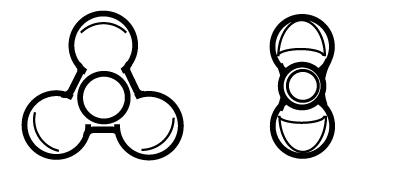
Investigation results
(1) Labeling and representation
Caution messages about target/non-target age group
Regarding 31 out of the 90 brands (34.4%), there was no Japanese caution message about target or non-target age group on packages or online order pages thereof.
Since children may touch the products as in the accident case, NCAC checked if there are caution messages on product packages, explanatory leaflets attached, or on online order pages.
Then, it was found that 31 out of the 90 brands (34.4%) did not have any age-related caution message in Japanese on packages, explanatory leaflets or online order pages. Of the 31 brands, 8 brands showed age-related cation messages in foreign language or in illustration.
Incidentally, 10 out of the 90 brands (11.1%) had age-related caution messages in Japanese only on packages or explanatory leaflets, while 10 out of the 90 brands (45.6%) had age-related caution messages in Japanese only on online order pages. Eight out of the 90 brands (8.9%) did not have such messages anywhere.
When solely looking at product packages and explanatory leaflets, 72 out of the 90 brands (80.0%) did not have any age-related caution message in Japanese.
Caution message about accidental ingestion and suffocation
45 out of the 90 brands (50.0%) did not have any Japanese caution message about accidental ingestion and suffocation on packages, explanatory leaflets or online order pages.
Since small children may put parts in their mouth as in the accident case, NCAC checked if there is any caution message about accidental ingestion and suffocation on packages, explanatory leaflets or online order pages7.
Then, it was found that 45 out of the 90 brands (50.0%) did not have any Japanese caution message about accidental ingestion and suffocation on packages, explanatory leaflets or online order pages. Of the 45 brands, 9 brands had such messages in foreign language (See the List).
Incidentally, 8 out of the 90 brands (8.9%) had Japanese caution messages about accidental ingestion and suffocation on packages or explanatory leaflets, while 33 out of the 90 brands (36.7%) had such messages on online order pages only. Four out of the 90 brands (4.4%) had such messages on all of them.
When solely looking at product packages and explanatory leaflets, 78 out of the 90 brands (86.7%) did not have any Japanese message about accidental ingestion and suffocation.
- 7 NCAC checked if caution messages like "Small parts are used for this product", "There is a risk of accidental ingestion and suffocation" are shown in Japanese.
List: Caution messages about accidental ingestion and suffocation in foreign language on product packages or explanatory leaflets
- "WARNING! CHOKING HAZARD Small parts not suitable for children under 3 years"
- "WARNING! CHOKING HAZARD Small parts Not for children under 3 years"
- "WARNING: CHOKING HAZARD-Small parts Not suitable for children under 36 months"
- "Safety Warning CHOKING HAZARD Small parts Not for children under 3 years old. Keep Awey From Eyes"
- "WARNING! CHOKING HAZARD Small parts not suitable for children under 3 years AVOID USING THIS PRODUCT NEAR EYES"
(2) Probability of coming off
When dropped from the height of 138 cm, parts of 16 brands out of 82 brands (19.5%) came off or fractured. All the parts were small enough for infants to accidentally ingest or choke on.
According to the accident case received by the Medical Facilities Network, the parts came off after the toy was dropped by the infant brother. Therefore, NCAC checked if any part would easily come off when each product was dropped and if the unfastened part was small enough for a child to accidentally ingest or choke on. NCAC conducted a drop test on 82 out of the 90 brands, which we were able to purchase more than one per brand.8
Since small children may touch the products as in the accident case, all the products were tested under the strictest conditions written in the drop test in the Safety Toy Standard (2016).9 Each specimen of the newly unpacked 82 brands was dropped ten times from the height of 138 cm on a vinyl floor tile.10 Regarding 9 brands out of the 82 brands (11.0%), screws of some wings were loosened when unpacked.
Test results showed that 16 brands out of the 82 brands (19.5%) included parts which came off or fractured. Of 16 brands of embedded-type, 6 brands were damaged (One out of 5 brands with button batteries was damaged). Of 26 brands of screw-in type, 8 brands were damaged. Of 40 brands of all-in-one type, 2 brands were damaged. How the parts came off differed depending on the structure or the detached portion (See Diagram 3). Some bearing caps came off regardless of the structure. Some bearings for wings came off.
- 8 The 82 brands included 16 brands of embedded type, 26 brands of screw-in type, and 40 brands of all-in-one type. Nine brands were with button batteries, which were composed of 5 brands of embedded type and 4 brands of screw-in type.
- 9 The standard of the Japan Toy Association specifies that the drop test for toys having a mass less than 1.4 kg for children under 18 months shall be repeated 10 times from the height of 138±5 cm, and that the drop test for toys having a mass less than 4.5 kg for children aged 18-96 months shall be repeated 4 times from the height of 93±5 cm. Each specimen shall be dropped on a vinyl floor tile of thickness around 3 mm on a layer of concrete having thickness of 64 mm or more. The hardness of the surface shall be Shore A 80±10. The surface area to be hit by the specimen shall be 0.3 m2 or more.
- 10 Each specimen was dropped 10 times on a vinyl tile on a layer of concrete having thickness of 100 mm (Shore hardness A 83) from the height of 138 cm. Every time after dropping a specimen, NCAC checked if any part came off from the specimen.
Diagram 3: Cases where parts came off or fractured during the drop test (16 out of 82 brands)
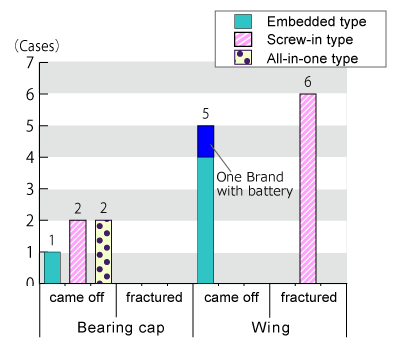
In reference to the descriptions of the small parts test11 in the Safety Toy Standard (2016), parts which came off or fractured were put into the small parts tester of inner diameter about 3 cm one by one toward arbitrary direction without pressure to see if each part fits in the tester. Test results showed that all the parts were small enough to pose a risk of accidental ingestion or choking.
- 11 It is stated that toys for children under 36 months and their removable parts or parts which came off in the drop test shall not fit in the small parts tester regardless of the relative position.
Doctor's comments
Dr. Yukihiro Michiwaki, Chief of special dentistry and oral surgery, Japanese Red Cross Musashino Hospital
Any foreign object in an infant's mouth is "dangerous when choking on it" and also "dangerous when swallowing it".
Small parts of various shapes are used for fidget spinners. Infants are likely to put everything in their mouth. It is very dangerous if a part small enough to enter infant's mouth comes off. It poses a risk of accidental ingestion and suffocation due to blockage of airway. Suffocation here means that a foreign object in the mouth obstructs the airway, which leads to lack of breathing and oxygen. Accidental ingestion means that a foreign object in the mouth enters the stomach through the esophagus. Foreign objects which dropped in the esophagus are usually excreted from the body. If the foreign object is a battery, however, the digestive tract may be perforated due to chemical burns, which leads to peritonitis, and in the worst case, death. Some foreign objects may not be excreted from the body and have to be removed by laparotomy.
(1) Suffocation
The mechanism of suffocation was analyzed by computer simulation using body data of 9-month-old infants and data of toys to see how a small part in the mouth may obstruct the airway.
Examples of suffocation due to pharyngeal or laryngeal obstruction
Diagram 4a: Example of suffocation due to pharyngeal obstruction 12
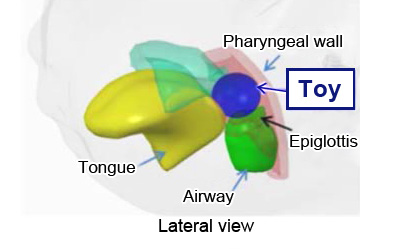
- shape
- sphere
- diameter
- 15 mm
- hardness
- rigid
- friction coefficient
- 0.05
- reflection coefficient
- 0.03
Diagram 4b: Example of suffocation due to laryngeal obstruction 12
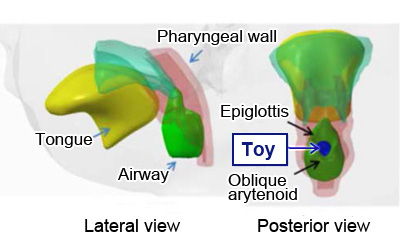
- shape
- sphere
- diameter
- 6 mm
- hardness
- rigid
- friction coefficient
- 0.05
- reflection coefficient
- 1.0
Suffocation due to pharyngeal obstruction is a status where the throat (pharynx) is fully blocked due to swallowing a foreign object of size 14-20 mm. Suffocation due to laryngeal obstruction is a status where the larynx is blocked due to swallowing a foreign object of size 5-10 mm. Even an object with a hole may obstruct fluid food and may cause suffocation. An infant pharynx is smaller than the widest open mouth. The distance between the oral cavity and the throat is shorter than that of adults. Infants have much saliva than adults. Infants do not have enough power to swallow or vomit an object when it is caught in the throat. Due to these physical characteristics, infants are more prone to choking than adults.
- 12 The original Japanese text was extracted from "Report on investigations into the cause or source of an actual or potential accident based on Article 23-1 of the Consumer Safety Act (infant's airway obstruction with a toy)" released by the Consumer Safety Investigation Commission on November 20, 2017.
(2) Response to accidental ingestion or aspiration by a child
If a child have or may have accidentally ingested or swallowed a foreign object, see if the incident leads to suffocation. If the face color is a mixture of blue, purple and dark brown (cyanosis), the child is considered to be suffocated, and immediately should be given back blows so that the foreign object may be ejected from the mouth. If not suffocation, the foreign object is considered to be ingested. Check what was ingested and take the child to a hospital. In that case, bring the same object that was swallowed and package thereof if any.
Advice for consumers
(1) Small parts pose a risk of accidental ingestion or choking. Don't let infants touch fidget spinners and their parts.
It is said that children aged three years old or younger are likely to put everything in their mouth13. Investigation results showed that some parts used for fidget spinners are small enough to enter an infant's mouth. Small parts pose a risk of accidental ingestion or suffocation due to blockage of airway. Keep fidget spinners and their parts out of reach of infants. If there's any small child in your house, make sure that fidget spinners or their small parts are not left within reach of the small child after fidget spinners are used.
- 13 The passage was cited from children's typical exploratory strategies in the JIS Z 8050:2016 "Safety aspects - Guidelines for child safety in standards and other specifications".
(2) Before a fidget spinner is used, check if parts of the toy have any protrusion or slack.
When a bearing cap or wing of a fidget spinner was protruded or any screw thereof has slack and the fidget spinner was dropped, small parts of some brands came off or fractured. Screws of some brands were loosened when unpacked. Before a fidget spinner is used, a parent or carer should check if parts of the toy have any protrusion or slack, and should advise users not to give impact to a fidget spinner (e.g. no throwing while playing with it).
(3) If an infant accidentally ingested a foreign object, take the infant to a hospital.
If an infant accidentally ingested a foreign object, check what was ingested and take the infant to a hospital. A button battery is particularly dangerous if ingested because it may damage the airway or digestive tract. The victim should be seen by a doctor immediately. When seeking medical advice, bring the same object that was ingested and package thereof if any.
Requests to businesses
(1) NCAC requests manufacturers to develop safer design products and conduct thorough quality control to prevent the occurrence of accidental ingestion and suffocation.
Some of the investigated fidget spinners had loose screws when unpacked. When dropped, small parts or battery cases of some brands were ejected. NCAC requests manufacturers to develop safer design products so that parts do not easily come off or fracture and to conduct thorough quality control to make sure that no product has loose screws.
(2) NCAC requests manufacturers to show the target age group and caution messages on product packages and explanatory leaflets.
Some of the investigated brands did not show the target age group or caution messages on product packages or explanatory leaflets. Some of them showed caution messages only in foreign language or in illustration. NCAC requests manufacturers to clearly show the target age group and caution messages on product packages or explanatory leaflets, which are conspicuous for consumers.
